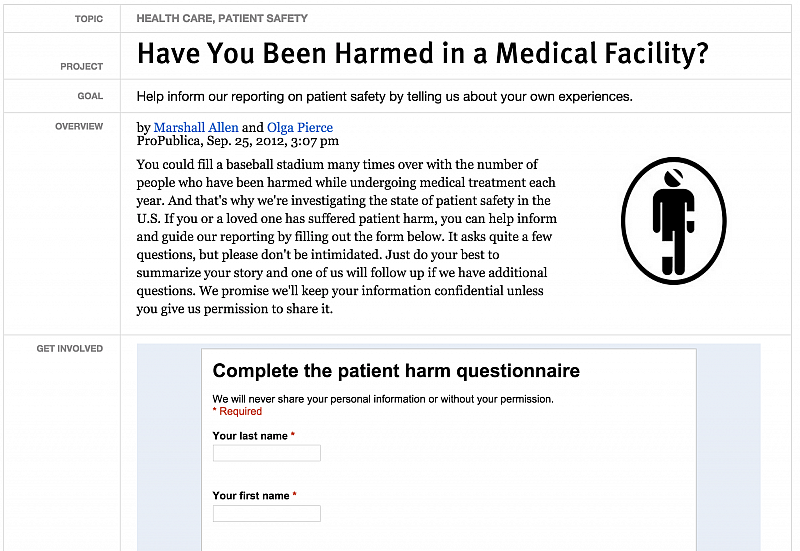Panel: Community engagement can and should change how you report

How are you reaching your audience?
The days of publishing a story and then walking away while it’s fawned over by an attentive audience are very much over (if they ever existed).
The mantra of the day is now “community engagement,” which ideally starts long before a big reporting project is birthed and continues long afterward. From finding an angle and discovering sources to enlarging a story’s readership and maximizing its impact, the new ideal for enterprise projects begins and ends with outreach.
That was the underlying message shared by a panel of three journalists — each the leading voice of community engagement in their respective newsrooms — with fellows participating in this week’s California Health Journalism Fellowship.
Martin Reynolds, senior editor for community engagement at the Bay Area News Group, said that journalists should no longer see themselves as news “pushers” and be content with the idea “that we merely push out information, and then the community gratefully accepts the knowledge we bestow, and we’re done.”
“A lot of journalists think this: ‘Engagement isn’t part of my job description,’” he said. “Uh, yeah, it is.”
Reynolds, formerly the editor-in-chief of the Oakland Tribune, is well known for finding innovative new ways to engage often-underserved communities in the Bay Area. He’s created a lauded community storytelling program, led numerous public forums to accompany big reporting projects and organized classes such as “Facebook for Grandmas” to bring overlooked communities into the digital future.
“A great number of constituencies that we need to reach are not necessarily in the digital space — or you need to find what digital space they are in,” he said.
For Reynolds, it’s important that journalists think of themselves not just as reporters, but also as “facilitators and conveners of conversation.” He says journalists shouldn’t just be sideline observers; rather they should use their unique capacity to help their audiences find solutions to their biggest problems.
“We need to be invested more deeply in our communities and the issues we’re covering,” Reynolds said. “It doesn’t mean we become advocates, but it does mean that through the preponderance of our reporting, we can take a position. It’s not based on ideology — it’s based on what we know to be fact.”
Such calls to journalistic action may sound inspiring, or simply overwhelming, given overstretched newsrooms and ever-present deadlines. So how might journalists start down the path of doing more engagement in practice?
Reynolds suggests that reporters “include engagement in budget lines as you would a graphic or photo request.”
Catherine Stifter of Capital Public Radio, agrees. “In the ideal situation, community engagement is going to run parallel to your reporting process,” said Stifter, whose documentary series, “The View From Here,” involves an extensive engagement program. “It actually starts at the same time that you’re beginning your project.”
Stifter’s vision of community engagement emphasizes relationship building and immersion in communities. “The way to get started is to have real relationships,” she said. “You need to have real relationships with the people in your stories, have to have to real relationships with the organizations and stakeholders that work on the issues that the people on your stories are dealing with.”
Whether you call it deep reporting or community engagement, it starts with being present and attentive. “You have to go to places where you not necessarily turning on your tape recorder or pointing your microphone but instead just asking a lot of questions and better questions about what the stories are,” she said.
Blair Hickman, formerly of ProPublica and now audience editor at The Marshall Project, offered a very different, much more web-based model for cultivating audiences throughout extended projects. Her four-step outreach process, which takes advantage of online audience queries, is worth detailing:
1) Define your audience.
“You need to define your target audience,” Hickman said. “Who is impacted by what I’m reporting on? And who can provide expertise for what I’m reporting on?”
As an exercise, she recommends reporters develop a character sketch of the types of people the reporting will engage or interest and the types of experts that will be most relevant to the project.
2) Create a callout.
“This is just a fancy name for an online questionnaire that tells you what you want to know about people who are impacted by your reporting,” Hickman said.
As the name suggests, a “callout” is used to reach potential sources and subjects who can inform your reporting. Google Forms is one popular free tool for creating short questionnaires that can be embedded in a story and posted online.
Online callouts work best for issues of widespread relevance and when you have at least three to six months to report out the story, Hickman said. It also helps to offer potential respondents a sense of why you’re asking for their information and contact info.
“You want to explain why you’re doing this project and what the scope of it is,” she said. “You basically want to make people feel like they’re participating in something bigger than themselves.”
Pro tip: “Whenever possible, try to form your questions so the answers are structured,” Hickman said. Putting up empty open fields for people to fill in is typically less useful than asking very specific, structured questions on the topics you’re interested in.
For example, here’s the callout questionnaire used by ProPublica on one of its ongoing investigations.

“I think you can tell people what you’re working on, but still be kind of vague about it,” Hickman said in response to fears of getting scooped. “Just giving a taste of the topic is oftentimes enough.”
3) Research your groups.
Once your callout is ready to post online, don’t just expect potential respondents to come to you.
Hickman says reporters should ask, “Where do these people live on the internet? Where do they talk about whatever it is you’re reporting on, on the internet?”
This takes a little old-fashioned reporting. Are there Facebook groups devoted to your topic or sub-community? Reddit groups? Preferred Twitter hashtags? Other online forums and message boards they use?
4) Start engaging.
When you find groups relevant to your project online, Hickman advises reporters to become incrementally involved. Start liking a couple Facebook postings, or ask a few small questions. Don’t just spam the group with your reporting needs. Over time, you’ll build trust and find more doors will open.
And as you track discussions of various online groups, it’s worth noticing recurrent points of confusion or frustration or interest among posters. Hickman says these are chances to create “demand-driven content.” Ask yourself: “What can we do to provide value to this community? That’s what’s going to get them on your side.”
That could mean crafting explanatory pieces, posting resource guides, translating new studies into layman’s terms or Q&As with experts, for example. This creates new copy for your organization and also provides another opportunity to include a link to your callout questionnaire when you share such material with online groups.
Hickman says this overall approach has earned big dividends at her former employer. “This is what the Patient Harm investigation has largely been for the last three years,” she said, citing an ongoing ProPublica project by Marshall Allen and Olga Pierce.
Regardless of the framework, not every single community engagement effort is going to succeed. Audience interest may be slim. Some insular groups may question or reject a reporter’s digital advances. Marginalized communities may be skeptical of a journalist’s sudden interest, and journalists at times can have inflated expectations of gratitude from the targets of their outreach. But Reynolds says that, over time, such efforts build goodwill, trust and interest in communities.
Building constituencies doesn’t happen overnight. “The cumulative effect of engagement is like a brick in a wall, and you got to build it piece by piece,” he said.
Photo by Garry Knight via Flickr.

